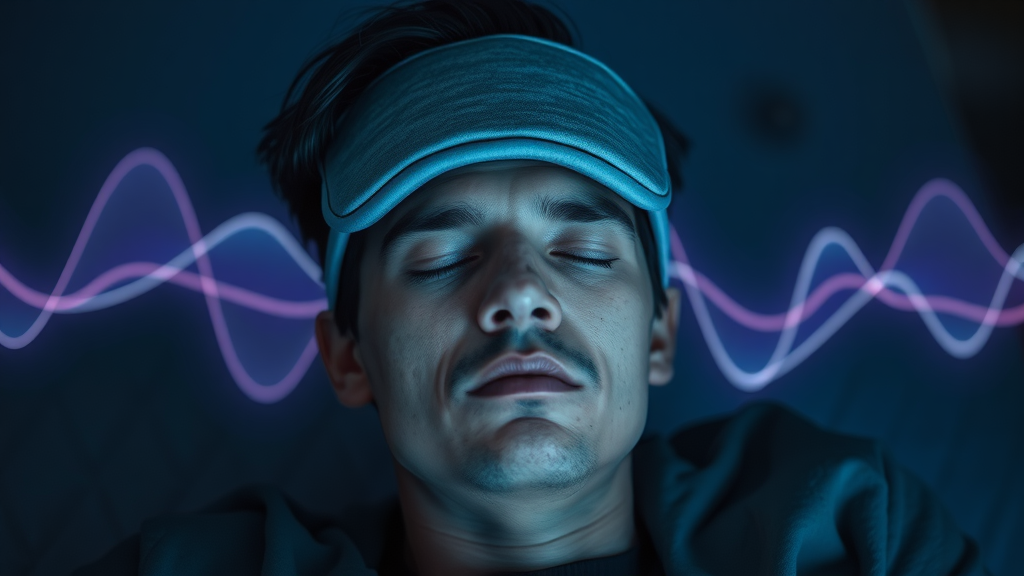Did you know that more than 35% of adults in the U.S. get less than seven hours of sleep most nights? Despite endless sleep aids and high-tech apps, a “sleeplessness epidemic” persists—blurring the line between tired days and restless nights. Now, growing numbers are turning to hypnosis for better sleep as an innovative way to finally fall asleep fast and awake truly refreshed. This comprehensive guide reveals the science, techniques, and myths behind using sleep hypnosis for deep, restorative sleep and renewed well-being.
Unlocking Rest: How Hypnosis for Better Sleep Can Transform Your Nights
If you’ve tried everything but still toss and turn, hypnosis for better sleep might be your missing piece. Unlike traditional sleep medicine, hypnosis gently guides the mind into a state where negative thoughts and stress can melt away—allowing the body to fully relax and drift into deep sleep. Modern research shows that sleep hypnosis can shorten the time it takes to fall asleep fast, increase the depth of sleep, and reduce nighttime waking. Best of all, it’s non-invasive and can be practiced at home. Whether your struggle is persistent insomnia or just the occasional restless night, understanding and applying hypnosis for sleep can lead to meaningful, lasting improvement in your sleep quality and mental health. Explore the step-by-step methods, sound science, and expert tips below to unlock truly restful nights and brighter days.

A Surprising Truth: Why Millions Struggle With Sleep Despite Modern Solutions
Modern society offers countless solutions—from high-tech devices to prescription sleep medicine—yet millions still face sleep disorders and struggle to fall asleep fast. A combination of stress, poor sleep hygiene, and underlying mental health conditions hampers natural sleep cycles. Many conventional remedies mask symptoms rather than address the root causes of sleeplessness. Here, hypnosis for better sleep emerges as an alternative that works with your mind’s natural rhythms, helping to reset anxious thoughts and the body’s sleep responses. By using guided focus and suggestion, hypnosis transitions both mind and body into a state uniquely suited for deep sleep, rather than simply sedating or distracting. This approach is gaining recognition, especially for those seeking an effective, evidence-backed alternative to traditional sleep medicine or cognitive behavioral therapy.
"More than 35% of adults in the U.S. get less than seven hours of sleep most nights—a sleeplessness epidemic prompting a quest for innovative solutions like hypnosis for better sleep."
What You'll Learn About Hypnosis for Better Sleep
The science behind sleep hypnosis
How hypnosis for sleep and deep sleep works
Common myths about hypnosis for insomnia
Step-by-step guidance to practice hypnosis for better sleep
The role of nature sounds and mental health
Expert insights about health conditions affecting sleep
Understanding Hypnosis for Better Sleep: Definition and Foundations
What Is Sleep Hypnosis?
Sleep hypnosis is a natural, guided process that helps individuals enter a relaxed, suggestible state—sometimes called a ‘hypnotic state’—where the subconscious is more open to positive suggestions about sleep. Unlike stage hypnotism or popular media portrayals, therapeutic hypnosis for better sleep involves gentle instructions, calming imagery, nature sounds, and progressive relaxation. The aim is to reframe unhelpful, negative thoughts and address the anxiety or stress disorder that often contributes to insomnia and restless nights. By reaching deeper mental states, individuals are able to bypass conscious resistance and make lasting sleep improvements.

How Hypnosis for Sleep Differs from Conventional Approaches
Unlike sleep medication—which often induces artificial sleep or causes side effects—hypnosis for sleep addresses the mental and emotional roots of your sleep disorder. Cognitive behavioral therapy is another popular non-pharmacological approach, but hypnosis provides a uniquely rapid pathway to relaxation and subconscious change. Where sleep medicine acts on the body’s chemistry, hypnosis for better sleep uses the mind’s power to facilitate genuine deep sleep and more positive sleep outcomes. Additionally, tools like nature sounds and sleep hypnosis recordings can be used alongside other healthy routines for a more restorative effect.
The Link Between Hypnosis for Better Sleep and Mental Health
The connection between mental health and sleep quality is powerful—stress, anxiety, and depression are often underlying causes of insomnia. Hypnosis for better sleep can quiet the mind and redirect focus away from rumination, negative thoughts, and the emotional difficulties that keep people awake. In fact, research shows hypnotherapy is particularly useful for those with coexisting mental health conditions, helping to break cycles of sleeplessness and mood disturbance. By calming stress triggers and building resilience, sleep hypnosis promotes both emotional stability and improved sleep hygiene over time.
The Science Behind Hypnosis for Better Sleep
How Hypnosis for Better Sleep Affects Deep Sleep
Studies published in the Journal of Clinical Sleep Medicine reveal that hypnosis for better sleep can significantly increase time spent in deep sleep—the most restorative phase for the brain and body. Through targeted suggestions and relaxation, hypnosis not only helps you fall asleep fast but also “primes” the mind to stay in deeper sleep stages for longer. This is especially valuable for anyone facing fragmented sleep, chronic insomnia, or frequent night waking. When paired with healthy sleep hygiene and, in some cases, gentle nature sounds, the benefits are amplified: people experience fewer awakenings, improved restfulness, and greater morning alertness. This non-invasive approach is now recommended more often for sleep disorders, particularly when medications are undesirable or come with unwanted side effects.

Brain Waves, Mind Control, and Hypnosis for Sleep Quality
A common question is whether sleep hypnosis involves “mind control”—the reality is far different from Hollywood myths. Hypnosis for better sleep works by gently shifting your brainwaves from active, alert beta patterns to slower, calmer alpha and theta waves, the same frequencies found in deep sleep and meditation. This shift makes it much easier to fall asleep and stay asleep, as the mind becomes more receptive to sleep-promoting cues. Numerous randomized controlled trials highlight marked improvements in sleep quality, especially for those with anxiety or stress disorder-related insomnia. The real power of hypnosis lies in “mind focus” rather than mind control; you retain full awareness and remain in charge throughout the process, even as your body relaxes into genuinely restorative sleep.
Table: Comparing Sleep Quality Before and After Hypnosis |
||
Metric |
Pre-Hypnosis |
Post-Hypnosis |
|---|---|---|
Time to Fall Asleep |
45+ minutes |
20-30 minutes |
Sleep Duration |
5-6 hours |
7-8 hours |
Frequency of Waking |
3-5 times/night |
0-2 times/night |
Perceived Restfulness |
Low/Moderate |
High |
Hypnosis for Insomnia: Applications and Effectiveness
Using Hypnosis for Better Sleep with Insomnia and Other Health Conditions
Hypnosis for insomnia has become a game-changer for people who struggle with chronic sleeplessness. Unlike temporary fixes or over-the-counter sleep medicine, sleep hypnosis offers a sustainable, non-invasive option that addresses the thought patterns and physical tension contributing to insomnia. Studies highlight improvements not only in total sleep time but also in how quickly people fall asleep and how rested they feel each morning. Furthermore, sleep hypnotherapy can be beneficial for those with health conditions such as chronic pain, PTSD, or anxiety disorders, where traditional therapies might fall short.
"Hypnosis for insomnia offers a non-invasive treatment, focusing on redirecting thought patterns for improved restful nights."

Sleep Hypnotherapy vs. Sleep Medication
When comparing sleep hypnotherapy to traditional sleep medication, several differences become clear. Sleep medication may induce quicker drowsiness but often does not create true, restorative sleep and may lead to tolerance or side effects. By contrast, hypnosis for better sleep fosters natural, undisturbed deep sleep and helps reset the mind-body connection. Side effects are rare, and hypnosis can be incorporated into a holistic approach that includes cognitive behavioral techniques, nature sounds, and healthy routines. For those seeking long-term improvement in sleep quality and mental health, sleep hypnotherapy often provides better, more sustainable sleep outcomes than medication alone.
How to Practice Hypnosis for Better Sleep at Home
Setting up your sleep environment
Preparing for hypnosis for sleep sessions
Easy hypnosis techniques to help you fall asleep fast
Guided Sleep Hypnosis: Apps, Videos, and Recordings
The digital age has made it easier than ever to access guided sleep hypnosis—there are excellent apps, YouTube videos, and downloadable audio tracks designed to promote deep sleep and relaxation. Many recordings combine calming narration with nature sounds and gentle background music to help you fall asleep fast. When selecting a resource, choose those produced by professionals or organizations with expertise in mental health or sleep hypnotherapy. Experiment with evening routines to find the timing, setting, and content that work best for your specific sleep challenges and daily habits.
Incorporating Nature Sounds into Hypnosis Practices
Nature sounds—gentle rain, forest streams, ocean waves—can enhance the effectiveness of hypnosis for better sleep. These sounds signal the brain that it’s safe to relax, reducing arousal and paving the way for deep, unbroken rest. Integrate nature sounds into your sleep hypnosis either as a background element in guided recordings or through dedicated sound machines. Research shows pairing hypnosis for sleep with nature sounds may further boost relaxation, accelerate sleep onset, and improve sleep quality, especially for those sensitive to background noise or living in urban environments.

Best Hypnosis Techniques for Better Sleep
Progressive muscle relaxation
Counting down visualization
Affirmations for restful nights
Nature sounds pairing

Tips to Fall Asleep Fast with Hypnosis for Better Sleep
To fall asleep fast using hypnosis, create a calming evening routine that includes at least one of the hypnosis techniques above. Begin by dimming lights, avoiding screens, and ensuring the bedroom is quiet and comfortable. Use a recorded hypnosis session or try self-guided techniques—such as progressive muscle relaxation or counting backwards while taking slow, deep breaths. Pairing this with nature sounds or soft instrumental music can enhance focus and ease anxiety. Practice consistently and give yourself permission to drift, rather than forcing sleep. Over time, these methods retrain your brain for quicker, more restful sleep onset, even during stressful periods or changes in routine.
Table: Hypnosis vs. Traditional Relaxation Methods |
|||
Approach |
Effectiveness |
Ease of Use |
Research Support |
|---|---|---|---|
Sleep Hypnosis |
High for insomnia, deep sleep |
Moderate (guided or self-guided) |
Strong (multiple RCTs) |
Progressive Muscle Relaxation |
Moderate |
Easy |
Strong |
Nature Sounds |
Good (especially with hypnosis) |
Very easy |
Moderate |
Sleep Medication |
Varies, short-term |
Easy |
Mixed |

Common Myths and Misconceptions About Sleep Hypnosis
Mind Control and Sleep Hypnosis: Fact or Fiction?
One of the most persistent myths about hypnosis for better sleep is that it causes “mind control.” In reality, hypnosis is an enhanced state of focus and relaxation—at any time, you can choose to stop, wake, or shift your attention. Sleep hypnosis is about empowering you to regain control over your sleep quality and overcome negative patterns, not about losing autonomy. Clinical studies confirm that all hypnotic suggestions are voluntary; you’re in charge before, during, and after any session. Understanding this fact is key for those hesitant to try hypnosis for their sleep disorders or mental health condition.
The Role of Sleep Hygiene and Mental Health in Hypnosis for Better Sleep
Sleep hypnosis is most effective when paired with healthy sleep hygiene—consistent routines, no caffeine late in the day, minimizing screens before bed—and attention to mental health. Stress, anxiety, and unresolved emotional challenges can undermine even the best hypnosis techniques if not addressed. Practicing relaxation during the day, prioritizing physical activity, and seeking professional support for mental health conditions will support better results when using hypnosis for sleep. Think of hypnosis as a powerful tool, made even stronger when woven into a broader lifestyle that supports sleep and emotional wellness.

Potential Risks and Safety: Is Hypnosis for Better Sleep Right for You?
Negative Sides and Limitations of Hypnosis for Sleep
For most individuals, hypnosis for better sleep is safe, non-invasive, and free from side effects seen with many sleep medicines. However, rare side effects include headaches, temporary confusion, or emotional release—especially for those with complex mental health conditions. Hypnosis is not recommended as a sole treatment for severe psychiatric or neurological disorders, and its effectiveness can vary based on an individual’s openness, engagement, and underlying health conditions. It’s important to set realistic expectations: deep-seated insomnia or sleep disorders often require a multifaceted approach, potentially combining therapies under the guidance of professionals.
When to See a Healthcare Professional About Sleep Hypnosis
If you experience persistent sleep disturbances, worsening anxiety, or symptoms of a clinical sleep disorder, consult a sleep medicine specialist or mental health provider. Professional evaluation can identify contributing health conditions and ensure that hypnosis for better sleep is adapted to your individual needs. For those with past trauma or complex stress disorders, expert support can ensure safe, effective use of sleep hypnotherapy and integration with cognitive behavioral therapy or other evidence-based treatments.

Health Conditions Impacting Results from Hypnosis for Better Sleep
Physical health conditions—such as sleep apnea, restless legs syndrome, or chronic pain—can limit how much hypnosis for better sleep improves sleep quality if not addressed directly. Similarly, untreated depression, anxiety, or PTSD require specialized support alongside hypnotic techniques. For most, however, adding hypnosis and improving sleep hygiene brings measurable improvements, even if other treatments are needed. Tracking sleep patterns, documenting response to techniques, and open communication with healthcare providers will help maximize positive outcomes from any sleep hypnotherapy program.
Integrating Hypnosis for Better Sleep Into Your Daily Routine
Tracking progress—how to know hypnosis for better sleep is working
Combining sleep hygiene habits with hypnosis
Staying consistent: Tips for sustainable results

People Also Ask: Hypnosis for Better Sleep
Can you get hypnotised to sleep better?
Many individuals can benefit from hypnosis for better sleep. A trained professional can guide you through relaxation and suggestion techniques to promote restful nights, though results vary by person and mental health disposition.
Does sleep hypnosis really work?
Numerous studies indicate hypnosis for better sleep can help with insomnia, decrease time to fall asleep, and increase deep sleep stages—particularly when combined with nature sounds and healthy routines. Individual outcomes depend on health conditions and engagement in the process.
What is the negative side of hypnosis?
For most, hypnosis for better sleep is safe. Rare negative sides include headaches, temporary disorientation, or increased distress for those with certain health conditions. Always consult a healthcare provider before starting sleep hypnotherapy.
How to go to sleep in 30 minutes?
Practice sleep hypnosis or guided audio with nature sounds, focus on deep breathing, and limit screen time—these steps can help you fall asleep fast, often within 30 minutes, by preparing the mind for rest.
FAQs: Quick Guide to Hypnosis for Better Sleep
How long do effects of hypnosis for better sleep last?
Can children use sleep hypnosis techniques?
Is sleep hypnosis covered by insurance?
Should hypnosis for sleep be paired with other mental health therapies?
Key Takeaways
Hypnosis for better sleep is backed by research for insomnia and deep sleep improvement
Combining nature sounds and sleep hygiene boosts effectiveness
Risks are rare but consulting a professional is advised, especially if you have health conditions
Restful Nights Await: Try Hypnosis for Better Sleep Today
Take your first step toward restorative sleep by integrating hypnosis for better sleep into your nightly routine—your mind and body will thank you tomorrow!
 Add Row
Add Row  Add
Add 




Write A Comment